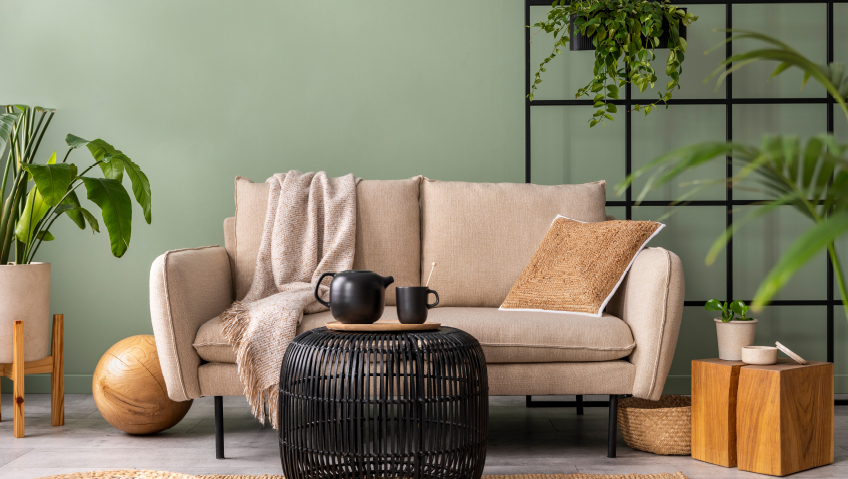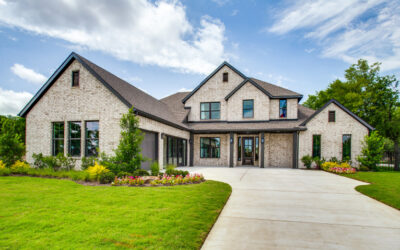Gleaming countertops and ample storage space aren’t the only things on people’s minds when they’re looking at buying or renovating a home. While the aesthetics of nesting are important, the new trends in interior design are focused on sustainability. How do the chosen materials and techniques impact the environment? Are there better choices for eco-conscious consumers that are still affordable?
After all, we spend about 90 percent of our time indoors, so we want to feel comfortable and at ease when we’re at home—and that also means feeling good about reducing our carbon footprint and producing less waste. The theme is threaded through most industry sectors as awareness of human-induced climate change causing disruption in nature and extreme weather events continues to mount.
According to consumer research, like the 2022 survey by First Insight and the Baker Retailing Center at the Wharton School of the University of Pennsylvania, buyers across all generations, from baby boomers to Gen Z, are driving the demand for sustainable products and services, and are willing to pay more for them. Almost 30 percent say they want to improve the environment, with 23 percent wanting to reduce production waste, 22 percent wanting to reduce their carbon footprint, and 17 percent concerned with animal welfare.
And who wouldn’t want to spend less on heating and electric bills?
If we look at improving energy consumption, for example, the cost of a home solar system has dropped by almost 70 percent over the last 20 years. The average American home, measuring roughly 2,480 square feet, will need 15 to 22 full-sized solar panels to replace traditional energy sources. Imagine homes that generate as much power as they consume. Well, it’s now possible.
The California Building Standards Commission approved a rule as of 2020 that requires all new homes built in the state to include solar panels. A first in the U.S., the rule includes an incentive for homeowners to add a high-capacity battery, charged by solar power, to their electrical system. And solar harvesting doesn’t have to be obvious, with large roof panels or shingles. Researchers at Michigan State University have developed a transparent luminescent solar concentrator that can be applied to windows or anything with a clear surface. With advances in technology, interior designers are incorporating solar power into large glass windows and partitions to create warm, light-filled spaces and energy efficiencies.
Beyond sunlight, bringing more of the outdoors in is also beneficial on a number of fronts. Air-purifying greenery in potted plants, wall hangings, and interior vertical gardens filled with fragrant blooms and easy to care for succulents are part of designer-chic in magazine spreads and show homes. Many studies have shown that indoor gardening and even being around plants at home can reduce stress and boost one’s mood.
Chris Pask, Director at Charlton Brown Architecture and Interiors, told Homes and Gardens, “Our attachment to the great outdoors has increased in the post-pandemic era and we are seeing this translate into the world of interior design. Clients are increasingly looking for a greater connection to the outdoors, whether that is a literal connection via roof terraces, balconies and beautifully landscaped gardens, or more subtle nods to greenery and nature throughout the home. This can take the form of colors, materials and shapes that mimic those found in nature and are known to invoke a sense of calm.”
Natural elements like sunlight and greenery are behind some of the key principles that make up eco-friendly trends in interior design. They are just some examples of renewable materials that replenish over time, like wood for furnishings and accent pieces that also bring warmth and comfort to indoor spaces. Other sustainable principles that people are seeking are more recycled content, where materials have been repurposed to create new elements, and locally sourced materials that reduce the impact that comes from transportation.
One of the simplest ways to refresh a space is paint, yet many paints contain volatile organic content, or VOCs. The lower the number, the fewer VOCs used in the paint. When it comes to eco-friendly paint, however, there is no clear-cut definition out there, according to Jonsara Ruth, cofounder and Design Director of the Healthy Materials Lab at Parsons School of Design. She encourages the use of mineral-based paints instead of acrylic paints. These include limewash paints that have some additives to prevent them from washing off. “It’s so much healthier for the environment and better for people,” Ruth told Architectural Digest. “Is it perfect? Not exactly, but it is as good as it gets.” Being mindful of how paints are disposed of and doing accurate calculations of how much paint is needed for a project can reduce environmental impact and waste as well.
Natural, more sustainable fibers are also seeing a surge in popularity, and rattan, bamboo and jute, also known as burlap, can be incorporated into different elements. From couches, ottomans, and rugs to bedroom headboards, jute brings a unique and natural impression to a room.
In addition to the materials chosen, the approach to design can also make a difference—taking advantage of natural light and ventilation to reduce energy use, for example. Adding smart thermostats or energy-efficient lights can also bring down energy consumption. And fixtures like recycled water systems reuse greywater.
Just as the fashion world is becoming more conscious of fast-fashion waste, opting for a timeless interior design can also reduce the need to change or update a room every season. Simply rearranging furniture and other flexible elements can also avoid a total overhaul of a space.
According to the U.S. Environmental Protection Agency, Americans throw out about 12 million tons of furniture every year, and because furniture contains multiple materials, virtually none of it ends up being recycled. The rethinking of furniture has seen the rise of smaller companies that sell refurbished or gently used furniture. Then there are the big furniture players like Ikea who created a program for refurbishing and reselling products in its stores. Analysts estimate that the second-hand furniture market will reach $16.6 billion by 2025.
Heading off waste materials is also something we’re likely to hear more about. For example, London-based design studio GoodWaste collaborates with department store Selfridges to use materials that would otherwise go to waste, transforming them into other interior elements. Co-founder Rafael El Baz told ArchDaily, “Normally as designers, we sit down and ask ourselves what we want to produce and then at a later stage start applying materials and colours and textures based on aesthetics and price. But with this method, we basically sit with a material in front of us and ask: what will this let us do?” This reversal drives creativity and challenges design professionals to innovate in new ways.
French design label Liaigre has launched a series of design objects made from upcycled fragments of wood, bronze, and leather that evokes a strong sense of eco-responsibility. Liaigre even uses vegetable glues for constructing the pieces, which include oak and textured bronze bookends. Other companies like Salvatori use stone offcuts that would otherwise go to waste to create geometrical patterns on top of stone for three-dimensional wall tiles.
Even in the bathroom, there are opportunities. Consider the toilet. While efforts have been made to reduce water usage, the Finnish company Woodio has come up with a new toilet that that is a composite of solid wood and resin-based adhesive which is 100 percent waterproof and mounted on the wall—all adding up to a significant reduction of its carbon footprint.
We have to find ways to replenish the Earth’s ecosystems, while meeting our own needs at the same time, architect Michael Pawlyn told Wallpaper magazine. “Humans need to return to a state where they are co-evolving with nature,” he said. He is one of the architects leading the charge for a shift toward regenerative design, which takes sustainable methods even further to support the “flourishing of all life.” Homes of the future need to nurture biodiversity and take carbon out of the atmosphere.
In fact, it’s already being done. Certain materials can be grown or made from atmospheric carbon, like wood, hemp, and straw. Cambridge University researchers have found that hemp can sequester carbon twice as effectively as forests, and can be grown in many parts of the world, with a positive impact on soil. With eco-trends influencing business, culture, and our dwellings, we’re at the early stages of better living, with the planet top of mind.













